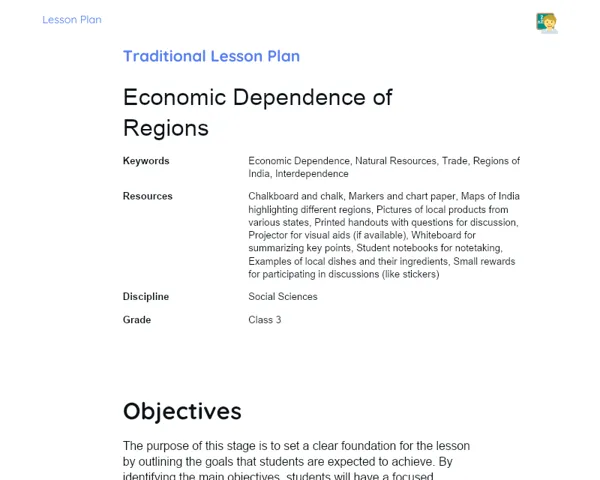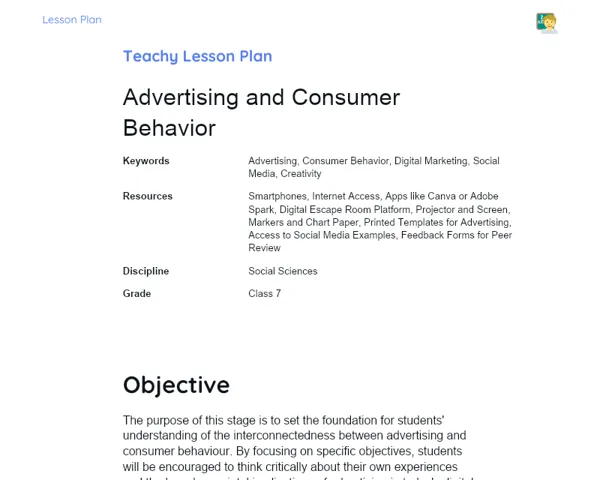Technical Lesson Plan | Analysis of Written Legends
| Palavras Chave | Written Legends, Cultural Heritage, Historical Context, Social Sciences, Analytical Skills, Creative Storytelling, Cultural Identity, Critical Thinking, Group Discussions, Real-World Connections |
| Materiais Necessários | Copies of local legends from Indian folklore, Whiteboard and markers, Projector (if available), Paper and pens for group activities, Mind mapping tools (optional), Access to online research resources or library materials, Presentation materials (posters, markers, etc.), Timer for activity management |
Objective
Duration: (10 - 15 minutes)
The purpose of this stage of the lesson plan is to establish a strong foundation for the students' understanding of written legends in relation to social sciences. By setting clear objectives, the teacher will guide students towards grasping the essential elements of historical narratives that shape cultural identities. This stage serves not only to clarify what students will learn but also to ignite their curiosity and engagement in the analysis of legends, fostering a deeper appreciation for the stories that inform their heritage and the world around them.
Main Objectives:
1. Students will understand the historical context and significance of various written legends.
2. Students will develop analytical skills to critically examine the elements and themes present in written legends.
3. Students will connect the learnings from written legends to real-world events and their implications in contemporary society.
Side Objectives:
- Students will enhance their research skills by exploring various sources of written legends.
- Students will improve their communication skills through group discussions and presentations of their analyses.
Introduction
Duration: (10 - 15 minutes)
The purpose of this introduction stage is to set the groundwork for students' comprehension of written legends by contextualizing their importance in social sciences. By facilitating an engaging initial activity, the teacher will capture students' interest and encourage teamwork, while providing them with analytical tools that will serve them throughout the lesson. This stage not only establishes the relevance of legends but also connects them with practical skills essential for their future careers.
Curiosities and Market Connection
Did you know that storytelling, including written legends, is a vital skill in many professional fields today? From marketing to journalism, the ability to convey messages compellingly is highly sought after. By analysing written legends, students will not only understand the significance of these stories but also enhance their ability to communicate effectively and creatively — skills that are crucial in the job market. For instance, businesses utilise storytelling in branding to connect with their audience, making this lesson not just about the past, but also relevant to the future career prospects of students.
Contextualization
Written legends are an integral part of our cultural heritage, often containing historical narratives that shape our understanding of society and its values. In the context of Social Sciences, analysing these legends allows students to explore the socio-political circumstances that have influenced them over time. Students will learn that legends are not mere tales; they embody the collective memory of communities, offering insights into their customs, beliefs, and aspirations. Understanding these narratives helps students appreciate the richness of their own culture while fostering an awareness of global histories. By linking past to present, legends serve as a bridge to understanding contemporary issues, making this lesson particularly relevant.
Initial Activity
Begin the class with a fun group activity: divide the class into small groups and assign each group a different local legend from Indian folklore, such as the story of 'Holi' or 'Ramayana'. Each group should read the assigned legend and prepare a brief presentation covering its main themes, characters, and moral lessons. This engaging activity will allow students to immerse themselves in the storytelling while preparing them for deeper analysis in the upcoming lesson.
Development
Duration: (30 - 40 minutes)
The purpose of this development stage is to deepen the students' understanding of written legends by introducing essential concepts, engaging them in reflective thinking, and providing practical challenges. This stage builds on the initial activity by fostering analytical skills and creativity, preparing students for a comprehensive examination of legends and their relevance in the social sciences.
Topics
1. Definition of Written Legends
2. The Role of Legends in Cultural Identity
3. Common Themes in Legends
4. Historical Context of Legends
5. Connection between Legends and Social Sciences
Thoughts on the Subject
How do written legends shape our understanding of history and society? Consider the similarities and differences between a legend you know and the historical events in your community. This exploration will prepare students for analyzing the legends in relation to their real-world significance.
Mini Challenge
Creating Your Own Legend
Students will create a short written legend that reflects their understanding of a historical event, incorporating elements like cultural significance, moral lessons, and unique characters.
1. Divide the class into small groups.
2. Each group should select a historical event from their community or school.
3. In their groups, brainstorm ideas on how to turn this event into a legend, focusing on characters and lessons.
4. Write a brief legend (around 250-300 words) that incorporates these elements.
5. Each group will present their legend to the class, highlighting the historical context and moral lessons.
The objective of this challenge is to encourage creativity while applying analytical skills to construct a narrative that links historical events to cultural values, enhancing the understanding of legends.
**Duration: (15 - 20 minutes)
Evaluation Exercises
1. Identify key elements of a selected legend and discuss how they reflect the values of the community it originates from.
2. Analyze a short written legend and answer questions on its themes, characters, and moral implications in relation to current events.
3. Create a mind map connecting the themes of legends to social issues faced in today's society.
Conclusion
Duration: (15 - 20 minutes)
The purpose of this conclusion stage is to consolidate the learning experience by reflecting on the students' engagement with the material and its relevance to both personal and professional contexts. Through discussion, summary, and closing reflections, students will solidify their understanding of written legends, ensuring they can appreciate the interplay between historical narratives and contemporary society. This stage serves as a vital transition to encourage students to apply what they have learned in their lives beyond the classroom.
Discussion
Facilitate a group discussion where students are encouraged to share their experiences and learnings from analyzing written legends. Start the discussion by asking each group to reflect on what they found most intriguing about their assigned legend. Prompt them to consider questions like: 'How did the legends reflect the cultural values of the community?' and 'What connections did you notice between the legends and current social issues?' This interactive discussion will allow students to consolidate their understanding by hearing diverse perspectives and stimulating critical thinking about the legends' relevance to modern society.
Summary
In this lesson, students explored the world of written legends, gaining insights into their historical significance and cultural importance. They learned that legends are not just entertaining tales; they are reflections of the values, beliefs, and struggles of the communities from which they originate. By engaging in activities that included group presentations and crafting their own legends, students developed vital analytical and communication skills, bridging the gap between historical narratives and contemporary societal themes. The activities fostered a deeper appreciation for storytelling as a means of preserving cultural identity and imparting moral lessons.
Closing
The exploration of written legends is not only essential for understanding one's heritage but equally important for professional development in today's job market. Skills such as critical analysis, creative storytelling, and effective communication are invaluable across various fields, from journalism to marketing. By mastering these skills through the study of legends, students are better equipped to convey messages that resonate with their audience, making them more competitive candidates in their future careers. The ability to connect historical narratives with current issues also enhances their capacity for empathetic leadership, a crucial trait in any professional setting.



